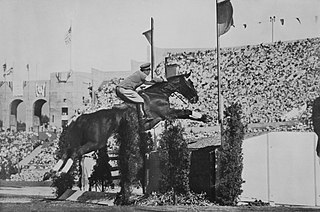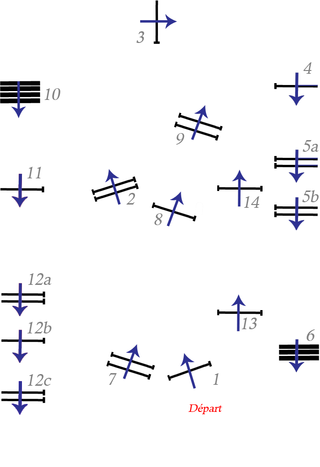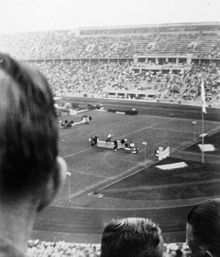The individual eventing event, part of the equestrian program at the 2004 Summer Olympics, was held from 15 to 18 August 2004 in the Olympic Equestrian Centre on the outskirts of Markopoulo in the Attica region of Greece. Like all other equestrian events, the eventing competition was mixed gender, with both male and female athletes competing in the same division.

The equestrian program at the 1912 Summer Olympics in Stockholm, included five medal events. There were individual competitions in dressage, eventing, and show jumping. Team scores were also gathered and medals awarded for teams in the eventing and jumping competitions. Equestrian had been absent from the Olympic program since the 1900 Summer Olympics, making the 1912 Games the second time the sport was featured. Ten nations competed: Belgium, Chile, Denmark, France, Germany, Great Britain, Norway, Russia, Sweden, and the USA. Only Sweden and Germany were able to supply a full team for all three disciplines, with several countries having several riders and horses used in two or even all three disciplines. A total of 88 entries ran in the three events, with 62 riders and 70 horses.
The equestrian events at the 1972 Summer Olympics in Munich included show jumping, dressage and eventing. All three disciplines had both individual and team competitions. The equestrian competitions were held at 3 sites: an existing equestrian facility at Riem for the individual show jumping and eventing competitions, the Olympic Stadium in Munich for the Nations Cup, and Nymphenburg, a Baroque palace garden, for the sold-out dressage. 179 entries, including 31 women, competed from 27 countries: Argentina, Australia, Austria, Belgium, Bolivia, Bulgaria, Brazil, Canada, Chile, Denmark, the German Democratic Republic (GDR), France, the Federal Republic of Germany (FRG), Great Britain, Hungary, Ireland, Italy, Japan, Mexico, the Netherlands, Poland, Portugal, the Soviet Union, Spain, Sweden, Switzerland, and the United States. The youngest participant was Kurt Maeder from Switzerland at 19 years old, while the oldest rider was Lorna Johnstone from Great Britain at 70 years old.

Equestrian sports were first included in the Olympic Games in the Summer Olympics of 1900 in Paris. They were again included in 1912, and have been included in every subsequent edition of the Games. Currently, the Olympic equestrian disciplines are dressage, eventing, and show jumping. In each discipline, both individual and team medals are awarded. Since the XV Olympiad in Helsinki in 1952, women and men compete on equal terms.

The individual show jumping was an equestrian event held as part of the Equestrian at the 1964 Summer Olympics programme. The event was held on 24 October. There were 46 competitors from 17 nations. Each nation could have up to three riders. The event was won by Pierre Jonquères d'Oriola of France, the first rider to win two gold medals in individual jumping; he did so 12 years apart, with his first in 1952. It was France's third gold medal in the event overall, moving out of a tie with Italy at two for most all-time. Hermann Schridde, representing the United Team of Germany, took silver. Great Britain earned its second consecutive bronze in the event, this time with Peter Robeson taking the honors.

The individual show jumping was an equestrian event held as part of the Equestrian at the 1912 Summer Olympics programme. The competition was held on 16 July 1912 as the Stockholm Olympic Stadium. There were 31 competitors from 8 nations. Each nation was limited to a maximum of six riders. The event was won by Jacques Cariou of France, the nation's first victory in the individual jumping. The victory came with a challenge prize presented by Count Gyula Andrássy the Younger of Hungary. Rabod von Kröcher earned Germany's first medal in the event with his silver. Emmanuel de Blommaert of Belgium took bronze.

The individual show jumping event was part of the equestrian programme at the 1920 Summer Olympics. The competition was held on 12 September at the Olympisch Stadion in Antwerp. There were 25 competitors from 6 nations. The event was won by Tommaso Lequio di Assaba of Italy, with his teammate Alessandro Valerio earning silver. Carl Gustaf Lewenhaupt of Sweden took bronze. They were the first medals in individual jumping for both nations.

The individual show jumping was one of five equestrianism events on the Equestrian at the 1924 Summer Olympics programme. The competition was held on Saturday 27 July 1924. 43 riders from 11 nations competed. Nations were limited to four riders each; the team jumping event used the same results as this competition, with the top three individual scores counting for each national team. The individual event was won by Alphonse Gemuseus of Switzerland, with the nation winning its first victory in its debut in the individual jumping event. Tommaso Lequio di Assaba of Italy became the first person to win multiple medals in the event, taking silver to add to his 1920 gold. Adam Królikiewicz earned Poland's first individual jumping medal with his bronze.
The individual eventing event, part of the equestrian program at the 2000 Summer Olympics, was held from 20 to 22 September 2000 in the Sydney International Equestrian Centre. Like all other equestrian events, the eventing competition was mixed gender, with both male and female athletes competing in the same division.

The individual show jumping at the 1928 Summer Olympics took place on 12 August 1928 at the Olympic Stadium in Amsterdam. Scores from the individual competition were summed to give results in the team competition. There were 46 competitors from 16 nations. Each nation could send a team of three riders; 15 nations did so, while Japan had a single rider. The event was won by František Ventura of Czechoslovakia, the nation's first medal in individual jumping. France earned its first medal in the event since 1912 with Pierre Bertran de Balanda's silver. Charles-Gustave Kuhn took bronze, putting Switzerland on the podium for the second consecutive Games.
The individual eventing event, part of the equestrian program at the 1996 Summer Olympics, was held from 23 to 26 July 1996 in the Georgia International Horse Park, in Conyers, Georgia. Like all other equestrian events, the eventing competition was mixed gender, with both male and female athletes competing in the same division.

The individual show jumping event, part of the equestrian program at the 1996 Summer Olympics, was held from 29 July to 1 August 1996 at the Georgia International Horse Park, in Conyers, Georgia. Like all other equestrian events, the jumping competition was mixed gender, with both male and female athletes competing in the same division. There were 82 competitors from 24 nations. Each nation could have up to 4 riders. The event was won by Ulrich Kirchhoff of Germany, the nation's second consecutive victory in the individual jumping. It was the fourth consecutive Games at which Germany competed that the nation reached the podium in the event—gold in 1936 and bronze in 1952, before gold again in 1992 and 1996. The silver medal went to Wilhelm Melliger of Switzerland and the bronze to Alexandra Ledermann of France, the two of whom came out on top of a seven-way jump-off for second place.

The individual show jumping in equestrian at the 1948 Summer Olympics in London was held at the Wembley Stadium on 14 August. The competition consisted of a single round of jumping. In the case of a tie in points, a jump-off was arranged. The jump-off had no time limit, however, the time taken to complete the jump-off was used as a tie-breaker. The points from the individual competition were also used in the team competition. There were 44 competitors from 15 nations, with nations able to send up to three riders each. The event was won by Humberto Mariles of Mexico, with his teammate Rubén Uriza taking silver at the top of a three-way jump-off for second place. Mariles' win was Mexico's first victory in the event. Jean-François d'Orgeix of France earned that nation's first individual jumping medal since 1928 with his bronze.

The individual show jumping in equestrian at the 1932 Summer Olympics in Los Angeles was held on 14 August. The event was called the "Prix des Nations" at the time. There were 14 competitors from 4 nations.

The individual show jumping event at the 2020 Summer Olympics is scheduled to take place on 3–4 August 2021 at the Baji Koen. Like all other equestrian events, the jumping competition is mixed gender, with both male and female athletes competing in the same division. 75 riders from 35 nations are expected to compete.
The team jumping in equestrian at the 1936 Olympic Games in Berlin was held at the Olympiastadion (jumping) on 16 August. The competition was also referred to as the "Prix des Nations."

The individual show jumping or "Prix des Nations" at the 1952 Summer Olympics took place on 3 August, at the Helsinki Olympic Stadium. It was the ninth appearance of the event. For the first time, the event featured two rounds. There were 51 competitors from 20 nations, with each nation able to send a team of up to three riders with the results shared between team and individual events. The event was won by Pierre Jonquères d'Oriola of France, the nation's first victory in individual jumping since 1912 and second overall. Óscar Cristi of Chile took silver for that nation's first medal in the event. German rider Fritz Thiedemann earned bronze.

The individual show jumping at the 1956 Summer Olympics took place on 17 June, at the Stockholm Olympic Stadium. The event was open to men and women, with two women competing. It was the 10th appearance of the event. There were 66 competitors from 24 nations, with each nation able to send a team of up to three riders and the team and individual events sharing results. The event was won by Hans Günter Winkler of the United Team of Germany, a victory in the debut for that nation though Germany had won in 1936. Brothers Raimondo D'Inzeo and Piero D'Inzeo took silver and bronze, respectively, the first medals for Italy in individual jumping since 1924.

The individual show jumping at the 1960 Summer Olympics took place on 7 September, at the Stadio Olimpico. The event was open to men and women. It was the 11th appearance of the event. There were 60 competitors from 23 nations. Each nation could have up to three riders. The event was won by Raimondo D'Inzeo of Italy, with his elder brother Piero D'Inzeo taking silver. The brothers were the second and third riders to win multiple medals in individual jumping; all three were Italian. It was the nation's first gold medal in the event since Lequio di Assaba's in 1920; Italy's two golds tied France for most all-time. David Broome earned Great Britain's first medal in the event with his bronze.

The individual show jumping at the 1992 Summer Olympics took place between 4 and 9 August at the Real Club de Polo de Barcelona. The event was open to men and women. There were 87 competitors from 30 nations. Each nation could have up to 4 riders. The event was won by Ludger Beerbaum of Germany, the nation's second victory in individual jumping. It was the third consecutive Games at which Germany competed that the nation reached the podium in the event—gold in 1936 and bronze in 1952. Piet Raymakers earned the Netherlands' first medal in the event with his silver. The United States reached the podium for the third consecutive Games with Norman Dello Joio's bronze.
















